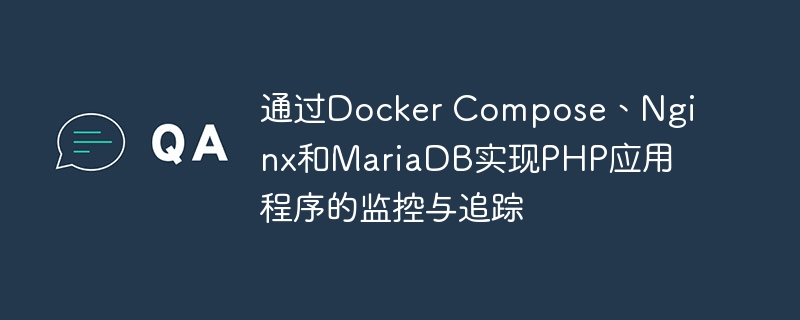

Monitoring and tracking of PHP applications through Docker Compose, Nginx and MariaDB
With the development of cloud computing and container technology, more and more applications Start deploying in a Docker container. In this case, how to monitor and track applications becomes an important issue. This article will introduce how to monitor and track PHP applications through Docker Compose, Nginx and MariaDB, and give specific code examples.
1. Preparation
Before starting, you need to prepare the following environment:
2. Create a Docker Compose file
Create a file named docker-compose.yml in any directory. The content of the file is as follows:
version: '3'
services:
web:
build: .
ports:
- "80:80"
db:
image: mariadb
environment:
- MYSQL_ROOT_PASSWORD=root
- MYSQL_DATABASE=test_db
volumes:
- ./data:/var/lib/mysqlIn the above In the file, we created two services, one is the web service and the other is the db service. The web service will build an image of the application and map port 80 to the host. The db service uses the mariadb image, specifies the root password and database name, and stores the data in the ./data directory of the host.
3. Create Nginx configuration file
Create a file named nginx.conf in the same directory as docker-compose.yml. The content of the file is as follows:
worker_processes 1;
events {
worker_connections 1024;
}
http {
server {
listen 80;
server_name localhost;
location / {
proxy_pass http://web;
}
}
}In In the above file, we configured Nginx to listen on port 80 and forward the request to the Docker service named web.
4. Create PHP application code
Create a file named index.php in the same directory as docker-compose.yml. The content of the file is as follows:
<?php
$dbhost = 'db';
$dbuser = 'root';
$dbpass = 'root';
$dbname = 'test_db';
$conn = new mysqli($dbhost, $dbuser, $dbpass, $dbname);
if($conn->connect_error) {
die("连接失败:" . $conn->connect_error);
}
echo "连接成功";
$conn->close();
?>In the above file, we connect to the MariaDB database through the mysqli extension and print out a successful connection message.
5. Build and run
Go to the same directory as docker-compose.yml in the terminal and execute the following command to build and run the container:
$ docker-compose build $ docker-compose up -d
Browse Open http://localhost in the server and you should see a successful connection message.
6. Monitoring and Tracking
In order to implement monitoring and tracking of PHP applications, we can use some common tools, such as:
The specific configuration steps are beyond the scope of this article, but we can refer to the following sample code for configuration.
Add the following services in docker-compose.yml:
prometheus:
image: prom/prometheus
volumes:
- ./prometheus.yml:/etc/prometheus/prometheus.yml
ports:
- "9090:9090"
grafana:
image: grafana/grafana
volumes:
- ./grafana-data:/var/lib/grafana
ports:
- "3000:3000"Create a file named prometheus.yml in the same directory as docker-compose.yml with the following content:
global:
scrape_interval: 15s
scrape_configs:
- job_name: 'php-app'
static_configs:
- targets: ['web:80']In the above file, we configured Prometheus to regularly collect indicator data on the web service.
Rebuild and run the container by executing the following commands to start Prometheus and Grafana:
$ docker-compose build $ docker-compose up -d
Open http://localhost:3000 in the browser, use the default username and password ( admin/admin) to log in to Grafana, then configure the Prometheus data source and create a dashboard to visualize monitoring metric data.
As for the configuration of Zipkin, you can refer to the official documentation and related sample codes to complete it.
Summary
Through Docker Compose, Nginx and MariaDB, we can easily build a monitoring and tracking environment for PHP applications. By configuring Prometheus and Grafana, you can collect and visualize application monitoring indicator data. By configuring Zipkin, you can track requests in your application. The above is a simple example, you can customize and adjust it according to actual needs and environment. Hope this article helps you!
The above is the detailed content of Monitor and track PHP applications through Docker Compose, Nginx and MariaDB. For more information, please follow other related articles on the PHP Chinese website!




